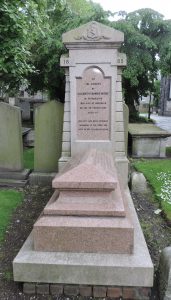Lady Elizabeth Crombie Duthie of Ruthrieston was born in 1818 to Alexander Duthie. Her father was a member of the wealthy family of merchants, ship owners and ship builders. She inherited considerable sums from her uncle Walter and brother Alexander Duthie, who had both been in the legal profession. In their memory she was determined to do something to benefit the people of Aberdeen. Therefore, in 1880 she purchased the 44 acre estate of Arthurseat by the banks of the River Dee for £30,000 and gave it to the City of Aberdeen to be developed into a park. The estate, on the north bank of the River Dee, was marshy ground covered with gorse and was traversed by a street, Sycamore Place. In the language of the day it was determined that the park be “available for all classes of citizens, that it should have a broad expanse of grassy sward upon which the young might indulge in innocent frolic and play…”. The work of designing the park was given to William R McKelvie of Dundee. Work progressed quickly with the first sod cut on 27th August 1881. The official opening of Duthie Park on 27th September 1883 was performed by HRH Princess Beatrice, substituting for her mother Queen Victoria who was recovering from an accident. Many of the original features of the park remain today, although they have evolved with time. Perhaps the best loved are the Winter Gardens, now known as the David Welch Winter Gardens. The original glass houses were opened in 1899. Today’s glasshouses were built following severe storm damage in 1969. They house the second largest collection (after the Eden Project) of bromeliads and giant cacti in the UK.

Elizabeth Duthie died on 30th March 1885 at the age of 67. Her substantial memorial in the Kirkyard at the Kirk of St Nicholas is shown in the photograph and has the epitaph “Her best and most enduring memorial is the park she gave to her fellow citizens”. The memorial also records other members of her family. There is a less obvious memorial to her in Duthie Park. In recognition of her contribution to the city, the council erected the ‘Hygeia Statue’, which was unveiled in 1897. The four lions around the plinth of the statue are supposed to represent the strong citizens in the park whilst Hygeia is the Goddess of Health, shown holding a cup from which a snake drinks (a symbol linked with various health related professions). There is a third memorial to Elizabeth Duthie in the city – a plaque outside 34 Maberly Street where she lived. The original house was demolished fairly recently. A portrait of her, painted in the year she died, is owned by Aberdeen Art Gallery.